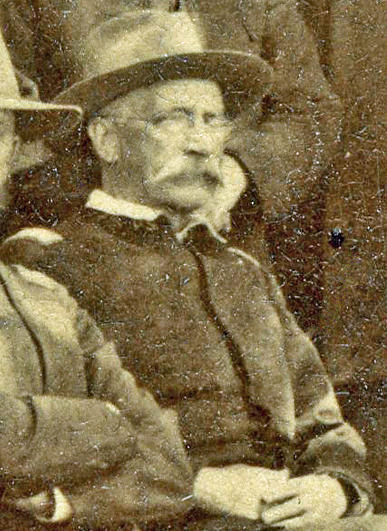

Colonel Charles Augustus Wikoff
Commanding Officer 22nd Infantry
January 28, 1897 - July 1, 1898
Charles A. Wikoff was born in Easton, Pennsylvania on March 3, 1837.
On April 20, 1861 he enlisted as
a Private in Company H of the 1st Pennsylvania Infantry.
On May 14, 1861 he was offered a commission as a 1st Lieutenant
in the US 15th Infantry.
On June 25 of that year he was discharged from the 1st
Pennsylvania Infantry and accepted the commission
in the Regular Army. On April 7, 1862 he was awarded the
temporary brevet rank of Captain for
gallant and meritorious service at the battle of Shiloh,
Tennessee. In this battle he was wounded
and lost his left eye. On November 25, 1863 Wikoff was awarded
another brevet, this time to Major
for gallant and meritorious service in the battles of
Chickamauga, Georgia and Missionary Ridge, Tennessee.
|
Charles A. Wikoff As an officer in the 15th Infantry. Photo taken prior to the Battle
of Shiloh, Photo from: That Body of Brave Men: The U.S.
Regular Infantry by Mark Wells Johnson Publisher Da Capo Press, 2003 |
The following passage describes the
action in which Wikoff, as a 1st Lieutenant
in the 15th Infantry, lost his eye at the Battle of Shiloh:
 ¹
¹
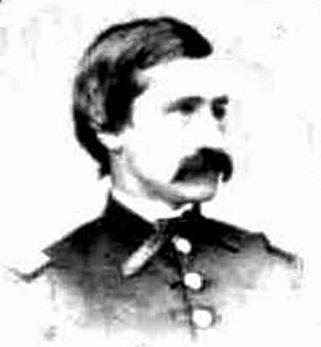
A photo of Charles A. Wikoff during the
Civil War.
The website editor believes this photo was taken after Shiloh
as his left eye appears to be damaged.
Photo by Eckert1732 from Ancestry.com
On August 15, 1864 Wikoff
received a promotion to the permanent rank of Captain in the
Regular Army.
He was transferred to the 24th Infantry on September 21, 1866. On
April 25, 1869 he was transferred
to the 11th Infantry where he commanded Company E from 1869-1886.
From 1869 to 1876 he served
with the 11th Infantry in the Department of Texas and from 1877
to 1886 he served with the Regiment
in the Department of the Dakotas.
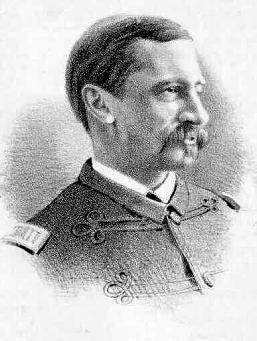
An illustration of Charles Wikoff as a
Captain in the 11th Infantry, ca. 1869-1886.
He is wearing the officer's undress or field coat model
1872, with black braid
extending from each button and terminating in herringbone loops.
The artist has not tried to hide his injured left eye.
He was promoted to Major in the 14th Infantry on December 8, 1886.
On November 1, 1891 Wikoff was promoted to Lieutenant Colonel of the 19th Infantry.
On January 28, 1897 he was
promoted to Colonel of the 22nd Infantry and joined the Regiment
at Fort Crook, Nebraska on February 8, 1897.
Colonel Charles A. Wikoff took
the 22nd Infantry Regiment from its frontier post at Fort Crook,
Nebraska to the entrance to Santiago Bay, Cuba on June 20, 1898.
At that time he was transferred
to command of 3rd Brigade and Lieutenant Colonel John H.
Patterson
took the 22nd Infantry ashore at Daiquiri, the 22nd thus being
the first US Regiment to land on Cuban soil.
On July 1, 1898 Colonel Wikoff
led his Brigade across the San Juan River and pushed to within
five hundred yards
of the Spanish fortifications at San Juan Hill. He was hit by
enemy fire and died on the battlefield.
He was the most senior ranking
officer of the United States Army to die in action during the
Spanish-American War.
Though in command of a Brigade, he had not yet been promoted,
thus, at his death Wikoff's rank was still that of
Colonel of the 22nd Infantry.
The following passages from the
after action report of 1st Lieutenant Wendell Simpson
of the 9th Infantry describe the action in which Colonel Wikoff
was mortally wounded.


![]()
The following is another account of Wikoff's death:
Wikoff’s 3rd Bgd
crossed the Bloody Ford and was directed to pass behind the 1st
Bgd to deploy on the left. Col.
Wikoff double-timed his men to the sound of the guns when he fell
to a Mauser bullet.
His men carried the colonel back across the Bloody Ford where he
was hit again.
Dying in the Cuban river his last orders were 'Get on up boys,
they need you.'
From the Spanish War 1898, Inc. website
At the end of February 1902 the
22nd Infantry returned to the United States from their first
deployment
to the Philippines. On March 11, 1902 Regimental Headquarters and
2nd and 3rd Battalions returned to
duty station at Fort Crook, Nebraska. Two days prior to that
return the weekly Illustrated Bee in Omaha,
Nebraska published the following article about Wikoff which
included most of the body of a letter written
to Wikoff's widow by his Adjutant during the War with Spain
explaining the circumstances of Wikoff's death:
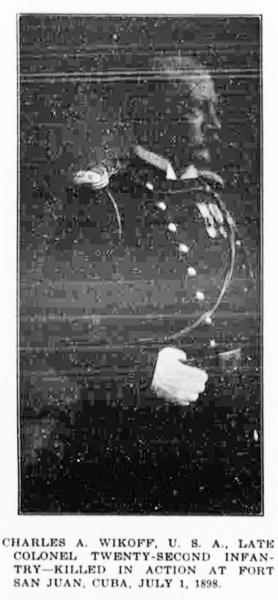
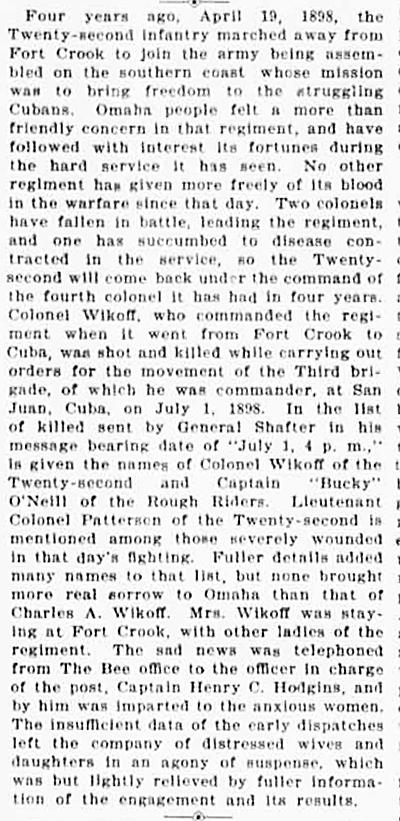
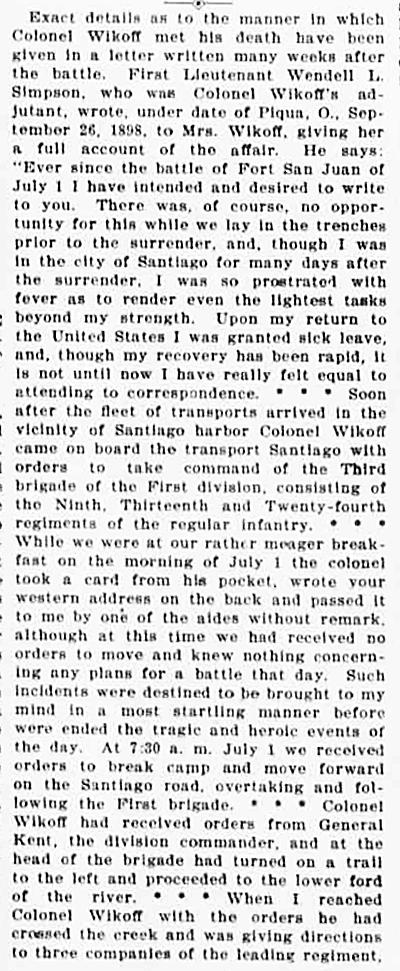
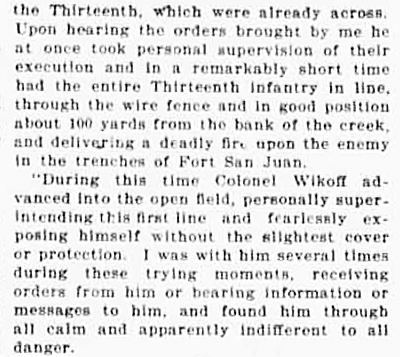
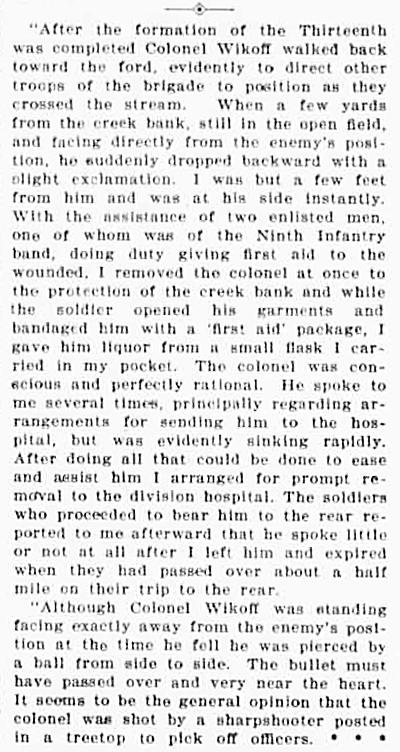
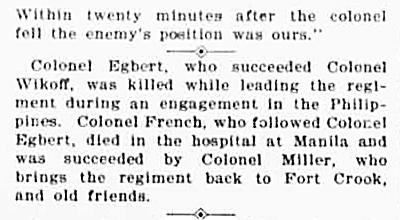
The Illustrated Bee March 9, 1902
From the Library of
Congress Chronicling America
Charles Wikoff was an Original Companion of the Military Order of the Loyal Legion of the United States.
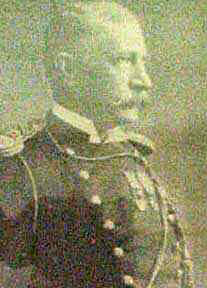
This portrait of Colonel Wikoff hung on
the wall at 1st Battalion 22nd Infantry Headquarters
at Fort Hood, Texas, 1999-2009. Photo courtesy of Major Anne
LeGare, wife of LTC Marc LeGare,
Commanding Officer 1-22 IN 1999-2001.
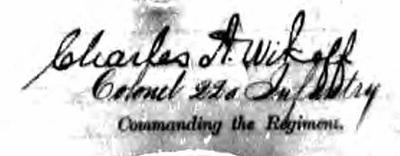
The signature of Charles A. Wikoff as
Commanding Officer 22nd Infantry
on the monthly Return of the 22nd Infantry for May 1897.
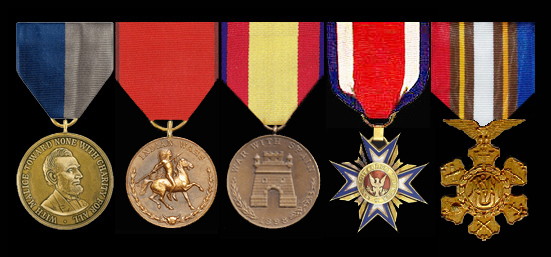
Charles Wikoff's decorations
**********************
Charles Augustus Wikoff (March 3, 1837-July 1, 1898)
Wikoff was born in
Easton, Pennsylvania, and graduated from Lafayette College with
bachelor's and master's degrees.
He worked as a civil engineer under George B. McClellan on the
Illinois Central Railroad from 1855 to 1857.
In April 1861, at
the outbreak of the American Civil War, Wikoff enlisted as a
private in the 1st Pennsylvania Infantry.
The next month he was commissioned a first lieutenant in the 15th
U. S. Infantry. He was shot in the left eye
at the Battle of Shiloh and wore an eye patch throughout the rest
of his life. He also participated in the
Battle of Chickamauga and the Battle of Missionary Ridge, for
which he was a brevetted major.
He was promoted to captain in August 1864
After the war,
Wikoff was transferred to the 24th U. S. Infantry, and later to
the 11th Infantry, serving in Texas
and the Dakotas. He was promoted to major of the 14th Infantry
stationed at Vancouver Barracks in
December 1886. In November 1891 he was made lieutenant colonel of
the 19th Infantry, and served at
Forts Wayne and Brady in Michigan. And, in January 1897, he
became colonel
of the 22nd Infantry at Fort Crook, Nebraska
In 1898 he led the
22nd Infantry from Fort Crook to Cuba where he was transferred to
lead the 3rd Brigade,
2nd Division of Major General William Rufus Shafter's V Army
Corps. He was shot during a charge across
an open field in the Battle of San Juan Hill. Within 10 minutes
his two successors William S. Worth and
Emerson Liscom were also shot before Ezra P. Ewers, the fourth in
command, assumed control.
He is buried in the Easton Cemetery
**********************
Easton's Charles
Wikoff Gave Up Law For The Military
TWO RIVERS HERITAGE
May 28, 1998|by S.M. PARKHILL (A free-lance story for The Morning
Call).
Events that happened during the
Spanish-American War in 1889 often are remembered better than the
war itself.
We all "Remember the Maine." Old salts rehash the
Battle of Manila Bay. For the Marines, it is Guantanamo.
The picture of Teddy Roosevelt and his Rough Riders charging up
Kettle Hill at San Juan came out of the Spanish-American War.
During this engagement, there was an enormous loss of life on
both sides.
It was at Santiago that Easton lost a hero, Col. Charles A.
Wikoff. He was a hero of both the Spanish-American War and the
Civil War.
Wikoff was born in Easton on March 8, 1837. After graduating from
Lafayette College in 1855,
he was employed as a civil engineer by the Illinois Central
Railroad Co.
He then studied law with William Davis of Stroudsburg. His life,
like that of so many others, was disrupted on April 12, 1861.
The Confederates fired on Fort Sumter, S.C. The fort was captured
on April 14, and the following day,
President Lincoln called for 75,000 volunteers.
Wikoff was two months shy of being admitted to the bar. He put
his legal career on hold and, on April 15, 1861, enlisted for
a three-month tour of duty. He entered service as a private in
Company H, First Pennsylvania Volunteers. A month later,
he was appointed first lieutenant in the 15th Regiment, U.S.
Regular Infantry, and was assigned duty in Tennessee.
On the first day of fighting at Shiloh, April 7, 1862, Lt. Wikoff
was wounded and lost his left eye. In the heat of battle,
Wikoff was presumed dead and left on the field.
His injury qualified him for immediate retirement, but he
refused. He wanted to serve until he was 64.
For meritorious service in the battle of Shiloh, he was brevetted
a captain April 7, 1862, although he did not receive
his captain's commission until more than two years later on Aug.
15, 1864. In the interim, he was made a brevet major
on Nov. 25, 1863, for bravery at Chickamauga and, later,
Missionary Ridge.
These were just a few of his many
promotions. What had started as a three-month enlistment became a
37-year career.
After the Civil War, Wikoff was transferred to the 11th Infantry
and stationed at Vicksburg and Jackson, Miss.
He played critical roles during the Reconstruction.
Wikoff's career then took him to Texas. Based at forts Concho and
Richardson, he was engaged in scouting.
He also guarded surveying teams that preceded construction of the
Southern Pacific Railroad.
From Texas, Wikoff went to the Dakota Territory, with the
Cheyenne Agency, and was stationed at Fort Sully for several
years.
Wikoff was transferred to Fort Vancouver in Washington, and then
to the Presidio in San Francisco.
Wikoff was considered an excellent officer and "an amiable
and social man" -- in short, the picture of an officer and a
gentleman.
When he returned East, Wikoff became a member of the District of
Columbia Commandery of the Loyal Legion,
and of the Army & Navy Club of Washington.
Wikoff was commissioned a major in the 14th Infantry on Dec. 8,
1886; lieutenant colonel, 19th Infantry on Nov. 1, 1891,
and colonel of the 22nd Infantry on Jan. 28, 1897.
On Dec. 3, 1872, Wikoff married Susan Pomp Mixsell, the eldest
living daughter of Charles Wagner Mixsell. Like Wikoff,
Susan was born in Easton on July 11, 1837. He was her second
husband. Susan was married on Dec. 7, 1859,
to a New York City man, Samuel Lawson. He died in October 1867.
The Mixsell house, behind the grapevine fence at S. 4th and Ferry
streets, Easton, is the home of the Northampton County
Historical & Genealogical Society. The Wikoffs apparently
considered this "home," but Army life kept them on the
move.
They were living at Fort Robinson, Neb., when the war with Spain
was declared on April 21, 1898. Col. Wikoff was assigned
to active duty and on June 21, sailed aboard a transport for
Santiago. He was in command of the 22nd Infantry Regiment.
En route, he was promoted to the rank of brigadier general and
detached from his regiment to command a brigade
consisting of three regiments: the 9th, 13th and 25th.
The strategy was to join in the capture of Cuba's second largest
city, Santiago. It was to be Wikoff's last military engagement.
On Tuesday, a fallen hero returns to Easton.
from The
Morning Call
(Ed., the promotion to Brigadier
General mentioned in the article above apparently never was
official.
Wikoff is listed in the Army Register of 1899 as being Killed In
Action as a Colonel of the 22nd Infantry.
He was nominated by President William McKinley on February 2,
1899 for appointment by brevet
to Brigadier General but no mention of the brevet being awarded
is in the Army Registers.)
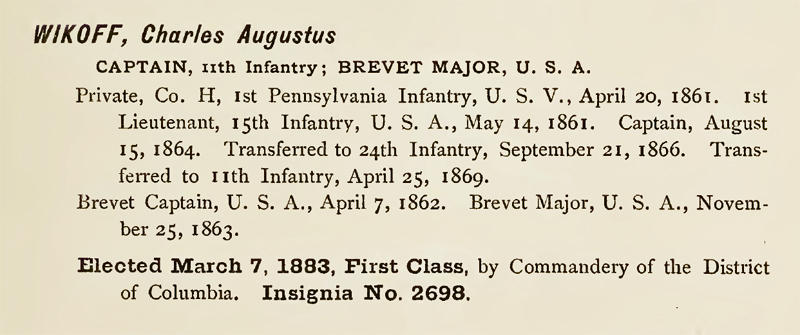
The entry for Charles A.
Wikoff in Military Order Loyal Legion Of The
United States Register
of the District of Columbia Commandery, March 1884,
printed by Judd & Detweiler in Washington DC.
Courtesy of Brenda M. Reinhart
COL U.S. Army (Retired)
See Colonel Reinhart's work at War and
Remembrance: Military History Publications
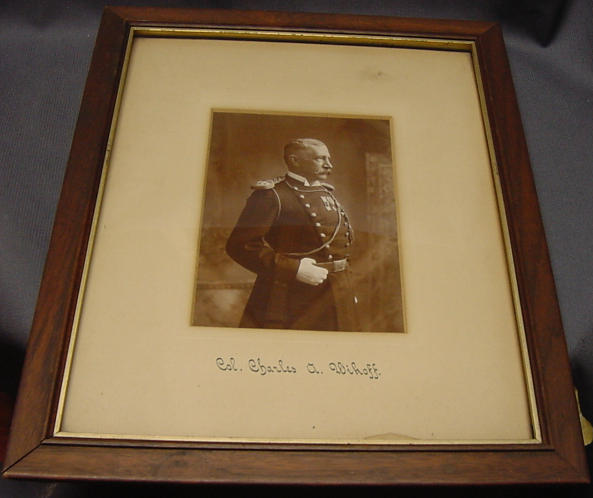
A formal portrait of Colonel Wikoff in
the collection of the
Northampton County Historical and Genealogical Society
Northampton County Historical and Genealogical Society
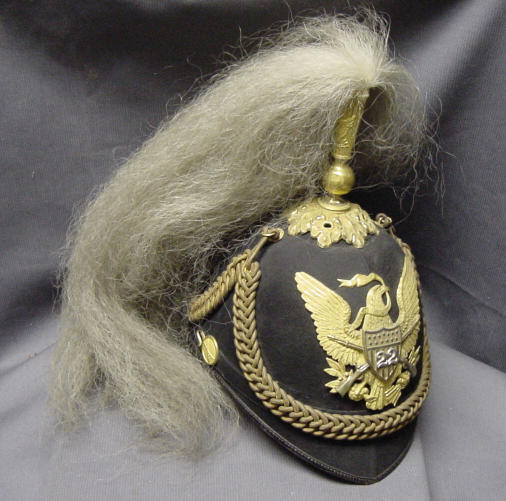
Model 1881-1902 dress helmet for
Infantry officers belonging to
Colonel Charles Wikoff. Note the German silver "22" on
the eagle's shield,
denoting the 22nd Infantry.
Northampton County Historical and Genealogical Society
Above: Officer's collar
insignia of the 22nd Infantry Right: Model 1860 Staff and
Field Officers Sword |
|
|
Left: A sketch of Colonel
Wikoff which appeared in the article Nearly all portraits of Wikoff
done after Shiloh show him facing |
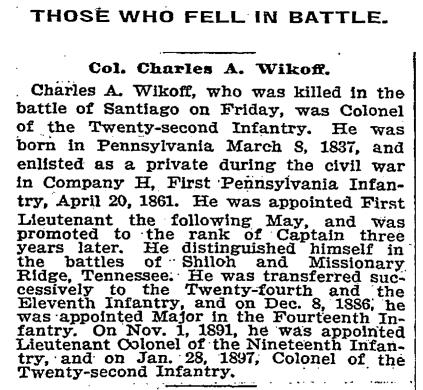
COL Wikoff's obituary, as it appeared in the New York Times, July 4, 1898
The body of Charles A. Wikoff
was returned to the United States aboard the transport Michigan
which left Cuba on October 12 and arrived in New York harbor on
October 19, 1898. He was then
transported to Easton, Pennsylvania where he was interred in
Easton Cemetery.
Burial:
Easton Cemetery
Easton
Northampton County
Pennsylvania
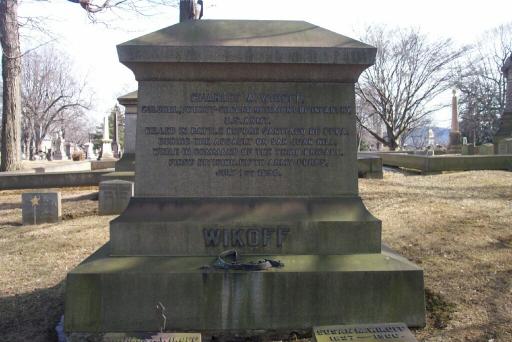
The grave of Colonel Charles A. Wikoff in Easton Cemetery.
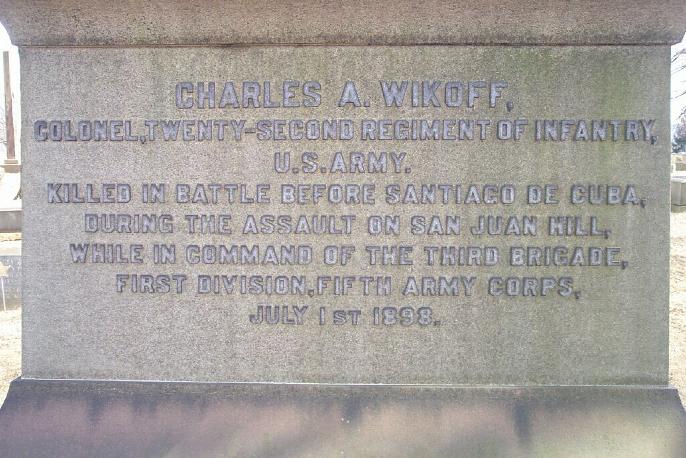
The inscription on Wikoff's grave
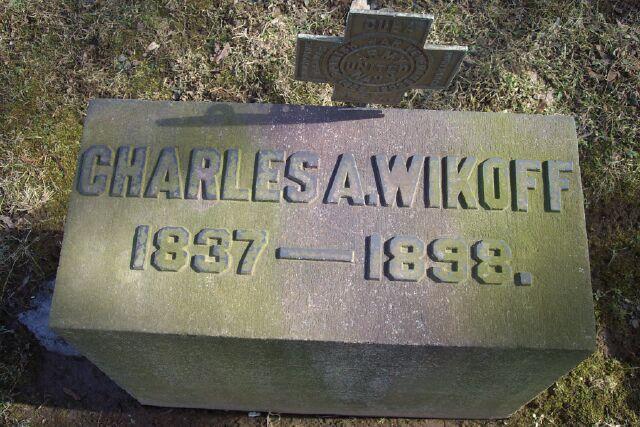
The marker for Charles A. Wikoff.
Note behind it the Spanish War Veterans marker.
**********************
Camp Wikoff
At the end of the War, because
of fear they were contaminated with yellow fever, typhus or other
diseases
thousands of American troops were sent home under quarantine to a
camp at Montauk Point, New York
where most remained for a minimum of thirty days before being
allowed to return home or to duty stations.
The camp was named Camp Wikoff
in honor of the popular commander of the 22nd Infantry
who gave his life a few months before, in the meadow below San
Juan Hill.
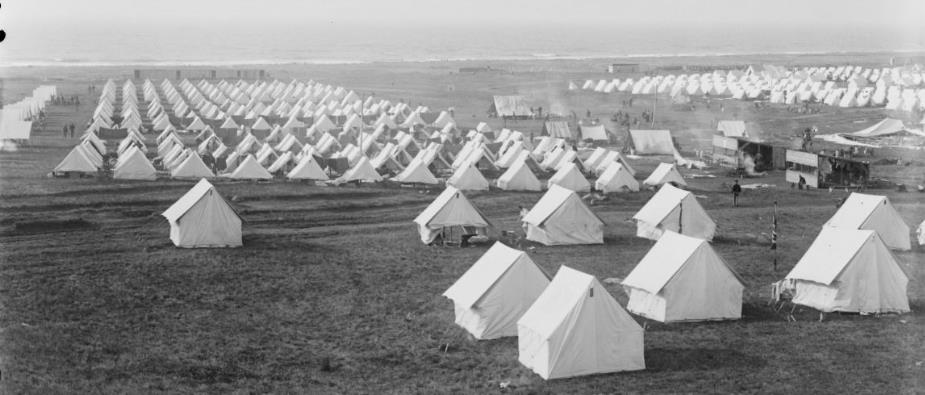
Camp Wikoff, Montauk Point, N.Y.
This view shows the 13th Infantry's
encampment, with the Atlantic Ocean in the background.
In the right of the photo is the 8th Infantry encampment. Out of
the picture, another several hundred
yards to the right was the encampment of the 22nd Infantry.
Theodore Roosevelt Collection, Harvard College Library
(Ed., More Americans were killed
in Cuba and Puerto Rico in 1898 by tropical diseases than by
combat action.
All returning Soldiers were quarantined for at least a month at
Montauk Point, New York in the hopes of
preventing the spread of such diseases to the US civilian
population.)
Camp Wikoff:
1898, Suffolk County, Montauk Point. Established August-September
1898 in vicinity of Fort Pond Bay
as a Federal demobilization and quarantine camp for troops
returning from Cuba at the close of the Spanish-American War.
Named for Col. Charles Wikoff, 22nd Infantry, killed before
Santiago at El Caney. Selected for its proximity to rail and
deep water anchorage, and because it was believed prevailing
offshore winds would hinder spread of tropical diseases
to the civilian population, from August to October 1898. Area
later used for National Guard annual training in the 1920s.
from New York State Military Museum website
(Ed., Wikoff was killed at San Juan Hill, not El Caney, as the above article incorrectly states.)
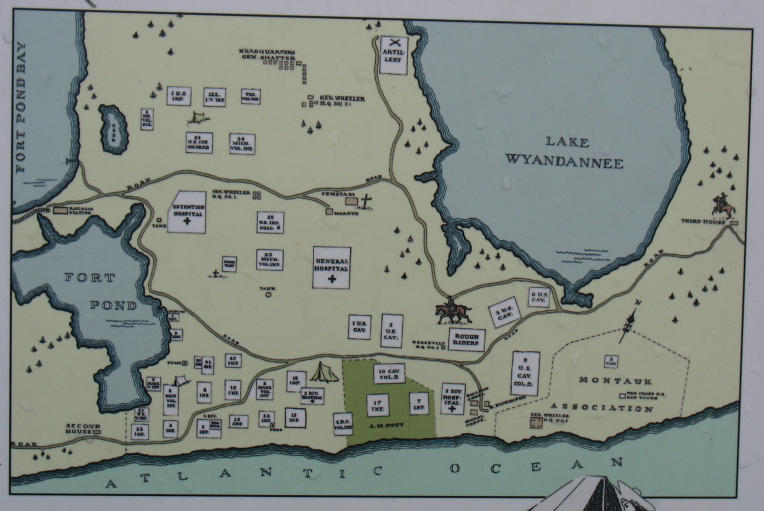
This photo of a map of Camp Wikoff was
prepared by Theodore Roosevelt County Park.
Lake Wyandanne was later renamed Lake Montauk. The camp was
constructed on what is now the occupied center
of Montauk, New York at the south edge of Fort Pond. The green
portion at the bottom is Shadmoor State Park.
The map shows all of the positions of the various encampments of
the Regular and Volunteer units returned from the war.
from New York State Military Museum website
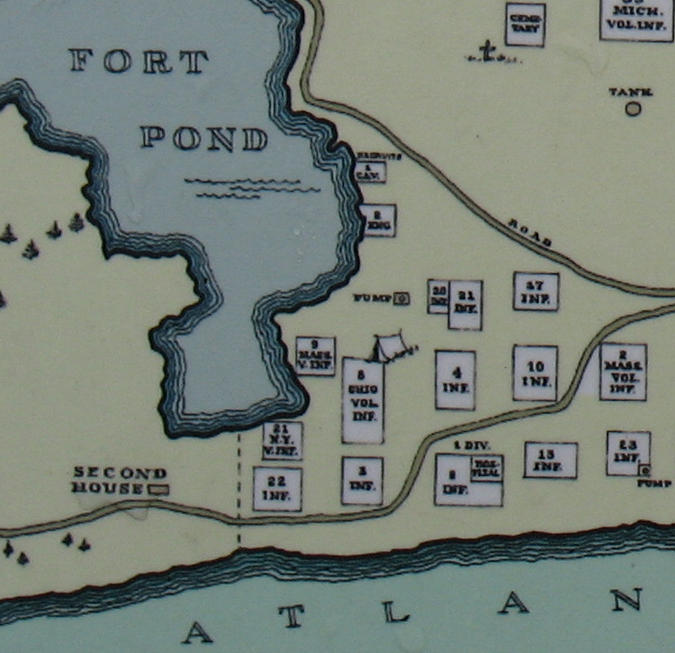
Enlargement of section of the above
map. The encampment of the 22nd Infantry
can be seen at the bottom left of center, right on the ocean.
from New York State Military Museum website
Souvenir badge |
Souvenir ribbon |
**********************
Top photo of COL Charles Wikoff taken at Tampa,
Florida 1898 as the 22nd Infantry prepared to depart for Cuba.
From a stereoview of 22nd Infantry officers taken at Tampa
copyright 1898 by Strohmeyer & Wyman
From the webmaster's collection
¹ That Body of Brave Men: The U.S. Regular
Infantry and the Civil War in the West
by Mark Wells Johnson, De Capo Press 2003
The 1st Battalion website is
grateful to the Northampton County Historical and Genealogical
Society,
and especially Andria Zaia, M.A., Curator of
Collections curator@northamptonctymuseum.org
for the use of the photographs of Colonel Charles A.
Wikoff's memorabilia.
Visit the website of the Society by clicking on the image below:
**********************
Home | Photos | Battles & History | Current |
Rosters & Reports | Medal of Honor | Killed
in Action |
Personnel Locator | Commanders | Station
List | Campaigns |
Honors | Insignia & Memorabilia | 4-42
Artillery | Taps |
What's New | Editorial | Links |